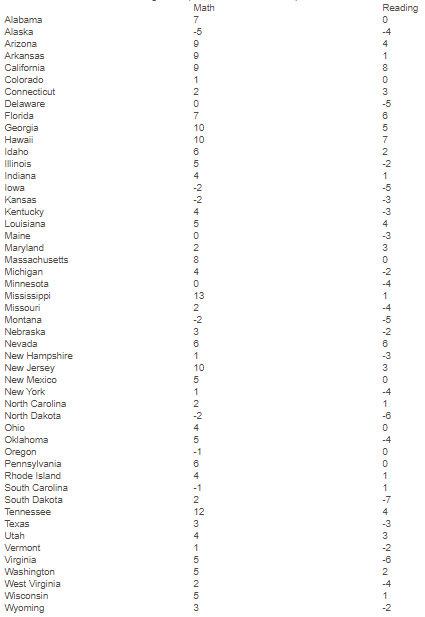 Editor’s note: redefinED executive editor Matt Ladner, responding to a request from EducationNext, made a prediction about 2019 NAEP scores prior to their release Wednesday. Ladner’s subsequent commentary for EducationNext, following the release, is published below. You can read reactions from other national education policy experts here.
Editor’s note: redefinED executive editor Matt Ladner, responding to a request from EducationNext, made a prediction about 2019 NAEP scores prior to their release Wednesday. Ladner’s subsequent commentary for EducationNext, following the release, is published below. You can read reactions from other national education policy experts here.
![]() Shakespeare’s Henry V includes a scene in which the young King of England reads off a list of casualties his army inflicted upon the French after the Battle of Agincourt, including a long list of French nobles.
Shakespeare’s Henry V includes a scene in which the young King of England reads off a list of casualties his army inflicted upon the French after the Battle of Agincourt, including a long list of French nobles.
“Here was a royal fellowship of death…” Henry notes grimly. This scene comes to mind when reviewing the 2019 NAEP, and states are generally not, alas, playing the role of Henry.
More on that in a bit.
I made three predictions before the release of the 2019 NAEP: that nationally scores would continue to stagnate, that the impact of the 2018 educator strikes would appear in the data, and that a statewide black student cohort would exceed a statewide average score for white students on the same test/year.
It looks like my caffeine-fueled oracle got two out of three: Nationally, scores continued to stagnate, and a black subgroup finally surpassed a white subgroup for the first time. Congratulations to black students in Massachusetts, who not only exceeded the statewide average score for the lowest scoring statewide average for white students on eighth-grade reading, but also moved into a tie with Arizona for the highest average score for black students on eighth-grade math.
The evidence on strikes at first glance appears inconclusive. Some jurisdictions like West Virginia and Los Angeles had very rough results. Other places without strikes also had rough results, and some of the jurisdictions with strikes like Arizona and Oklahoma had mixed results.
Special education results, on the other hand, are an Agincourt-level disaster.

NAEP eighth-grade reading and math gains for students with disabilities (2019 minus 2009 scores)
NAEP has been given to all states since 2003. After 16 years, this is what each state has to show for it in terms of eighth-grade math and reading gains. On these tests students, make approximately 10 points worth of progress on average per year between fourth and eighth grades.
Mind you that the United States spends high but has older students who score low on international exams, so most states had enormous room for improvement in 2003, especially among children of color:

NAEP eighth-grade math and reading gains (2019 minus 2003 scores)
No state managed to notch a double-digit gain in both math and reading during these 16 years. Plenty of states saw declines in scores.
Once more unto the breach, dear friends …